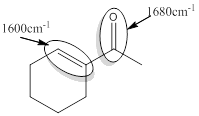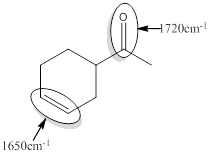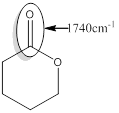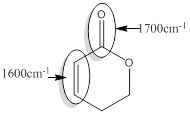
a)
Interpretation:
For the given compounds that absorbing the IR radiation in the range between 1600and 1850
Concept introduction:
Compounds that absorbing the IR radiation in the range between 1600and 1850
Reciprocal of wavelength is called wavenumber or Number of waves in one centimeter is called wavenumber
Unit of wave number is reciprocal of Centimeter.
According to Hooke’s law the factors affecting wave numbers are
1. Bond strength
2. Reduced mass
The conjugated compound produces a signal at lower wavenumber, because it has some single bond character and possess weak bond due to resonance.
To find: the responsible bonds for the IR absorption and wave number of the given compound
a)
Answer to Problem 38PP
The responsible bonds for IR absorption and the wavenumber of the given compound in the IR radiation range between 1600and1850

Explanation of Solution
For the given compound A the responsible bonds are,
Conjugated carbonyl and conjugated C=C bonds.
For the conjugated carbonyl bond approximate wavenumber is 1680
For the conjugated C=C bond approximate wavenumber is 1600
For unsaturated or conjugated carbonyl compound there is an introduction of C=C bond separated by one sigma bond.
In conjugated system
In the case of conjugated C=C bond,
(b)
Interpretation:
For the given compounds that absorbing the IR radiation in the range between 1600and 1850
Concept introduction:
Compounds that absorbing the IR radiation in the range between 1600and 1850
Reciprocal of wavelength is called wavenumber or Number of waves in one centimeter is called wavenumber
Unit of wave number is reciprocal of Centimeter.
According to Hooke’s law the factors affecting wave numbers are
1. Bond strength
2. Reduced mass
The conjugated compound produces a signal at lower wavenumber, because it has some single bond character and possess weak bond due to resonance.
To find: the responsible bonds for the IR absorption and wave number of the given compound
(b)
Answer to Problem 38PP
The responsible bonds for IR absorption and the wavenumber of the given compound in the IR radiation range between 1600and1850

Explanation of Solution
For the given compound B the responsible bonds are
Isolated carbonyl and C=C bonds.
For isolated or saturated carbonyl bond, approximate wavenumber is 1720
For isolated or saturated C=C bond, approximate wavenumber is 1650
Isolated carbonyl group has mostly double bond character.
So, isolated carbonyl compounds produces signal at higher wavenumber of 1720
Like the same way, Isolated C=C has mostly double bond character
So, isolated C=C produces signal at higher wavenumber of 1650
(c)
Interpretation:
For the given compounds that absorbing the IR radiation in the range between 1600and 1850
Concept introduction:
Compounds that absorbing the IR radiation in the range between 1600and 1850
Reciprocal of wavelength is called wavenumber or Number of waves in one centimeter is called wavenumber
Unit of wave number is reciprocal of Centimeter.
According to Hooke’s law the factors affecting wave numbers are
1. Bond strength
2. Reduced mass
The conjugated compound produces a signal at lower wavenumber, because it has some single bond character and possess weak bond due to resonance.
To find: the responsible bonds for the IR absorption and wave number of the given compound
(c)
Answer to Problem 38PP
The responsible bonds for IR absorption and the wavenumber of the given compound in the IR radiation range between 1600and1850

Explanation of Solution
For the given compound C the responsible bond is,
Carbonyl bond of an ester
For isolated or saturated carbonyl bond of an ester, the approximate wavenumber is 1740
Isolated or saturated ester produces the signal of higher wave number than that of conjugated or unsaturated ester of 1700
(d)
Interpretation:
For the given compounds that absorbing the IR radiation in the range between 1600and 1850
Concept introduction:
Compounds that absorbing the IR radiation in the range between 1600and 1850
Reciprocal of wavelength is called wavenumber or Number of waves in one centimeter is called wavenumber
Unit of wave number is reciprocal of Centimeter.
According to Hooke’s law the factors affecting wave numbers are
1. Bond strength
2. Reduced mass
The conjugated compound produces a signal at lower wavenumber, because it has some single bond character and possess weak bond due to resonance.
To find: the responsible bonds for the IR absorption and wave number of the given compound
(d)
Answer to Problem 38PP
The responsible bonds for IR absorption and the wavenumber of the given compound in the IR radiation range between 1600and1850

Explanation of Solution
For the given compound D the responsible bonds are,
Conjugated carbonyl bond of an ester
Conjugated C=C bond.
For conjugated carbonyl bond of an ester, the approximate wavenumber is 1700
For the conjugated C=C bond approximate wavenumber is 1600
Conjugated or unsaturated ester produces the signal of lower wave number than that of Isolated or saturated ester. In conjugated system
The reason behind it is conjugated carbonyl bond of an ester has single bond character due to resonance and therefore this bond is merely weaker.
In the case of conjugated C=C bond,
(e)
Interpretation:
For the given compounds that absorbing the IR radiation in the range between 1600and 1850
Concept introduction:
Compounds that absorbing the IR radiation in the range between 1600and 1850
Reciprocal of wavelength is called wavenumber or Number of waves in one centimeter is called wavenumber
Unit of wave number is reciprocal of Centimeter.
According to Hooke’s law the factors affecting wave numbers are
1. Bond strength
2. Reduced mass
The conjugated compound produces a signal at lower wavenumber, because it has some single bond character and possess weak bond due to resonance.
To find: the responsible bonds for the IR absorption and wave number of the given compound
(e)
Answer to Problem 38PP
The responsible bonds for IR absorption and the wavenumber of the given compound in the IR radiation range between 1600and1850

Explanation of Solution
For the given compound E the responsible bond for IR absorption is,
Isolated or saturated C=C bond.
For isolated or saturated C=C bond, approximate wavenumber is 1650
Isolated C=C produces signal at higher wavenumber of 1650
Want to see more full solutions like this?
Chapter 15 Solutions
ORGANIC CHEMISTRY GGC>CUSTOM<-TEXT
- Synthesis of 1-metilbenzotriazole from 1,2-diaminobenceno.arrow_forwardSynthesis of 1-metilbenzotriazole.arrow_forwardIndicate the formula of the compound, that is the result of the N- alquilación (nucleofílic substitution), in which an additional lateral chain was formed (NH-CH2-COOMe). F3C. CF3 NH NH2 Br о OMe K2CO3, DABCO, DMFarrow_forward
- Identify the mechanism through which the following reaction will proceed and draw the major product. Part 1 of 2 Br KOH EtOH Through which mechanism will the reaction proceed? Select the single best answer. E1 E2 neither Part: 1/2 Part 2 of 2 Draw the major product formed as a result of the reaction. Click and drag to start drawing a structure. Xarrow_forwardWhat is single-point calibration? Provide an example.arrow_forwardDraw the major product formed via an E1 pathway.arrow_forward
- Part 9 of 9 Consider the products for the reaction. Identify the major and minor products. HO Cl The E stereoisomer is the major product and the Z stereoisomer is the minor product ▼ S major product minor productarrow_forwardConsider the reactants below. Answer the following questions about the reaction mechanism and products. HO Clarrow_forwardjulietteyep@gmail.com X YSCU Grades for Juliette L Turner: Orc X 199 A ALEKS - Juliette Turner - Modul X A ALEKS - Juliette Turner - Modul x G butane newman projection - Gox + www-awa.aleks.com/alekscgi/x/Isl.exe/10_u-IgNslkr7j8P3jH-IBxzaplnN4HsoQggFsejpgqKoyrQrB2dKVAN-BcZvcye0LYa6eXZ8d4vVr8Nc1GZqko5mtw-d1MkNcNzzwZsLf2Tu9_V817y?10Bw7QYjlb il Scribbr citation APA SCU email Student Portal | Main Ryker-Learning WCU-PHARM D MySCU YSCU Canvas- SCU Module 4: Homework (Ch 9-10) Question 28 of 30 (1 point) | Question Attempt: 1 of Unlimited H₂SO heat OH The mechanism of this reaction involves two carbocation intermediates, A and B. Part 1 of 2 KHSO 4 rearrangement A heat B H₂O 2 OH Draw the structure of A. Check Search #t m Save For Later Juliet Submit Assignm 2025 McGraw Hill LLC. All Rights Reserved. Terms of Use | Privacy Center | Accessarrow_forward
- The electrons flow from the electron-rich atoms of the nucleophile to the electrons poor atoms of the alkyl halide. Identify the electron rich in the nucleophile. Enter the element symbol only, do not include any changes.arrow_forwardHello, I am doing a court case analysis in my Analytical Chemistry course. The case is about a dog napping and my role is prosecution of the defendant. I am tasked in the Area of Expertise in Neutron Activation and Isotopic Analysis. Attached is the following case study reading of my area of expertise! The landscaping stone was not particularly distinctive in its decoration but matched both the color and pattern of the Fluential’s landscaping stone as well as the stone in the back of the recovered vehicle. Further analysis of the stone was done using a technique called instrumental neutron activation analysis. (Proceed to Neutron Activation data) Photo Notes: Landscaping stone recovered in vehicle. Stone at Fluential’s home is similar inappearance. Finally, the white paint on the brick was analyzed using stable isotope analysis. The brick recovered at the scene had smeared white paint on it. A couple of pieces of brick in the back of the car had white paint on them. They…arrow_forwardCite the stability criteria of an enamine..arrow_forward
 ChemistryChemistryISBN:9781305957404Author:Steven S. Zumdahl, Susan A. Zumdahl, Donald J. DeCostePublisher:Cengage Learning
ChemistryChemistryISBN:9781305957404Author:Steven S. Zumdahl, Susan A. Zumdahl, Donald J. DeCostePublisher:Cengage Learning ChemistryChemistryISBN:9781259911156Author:Raymond Chang Dr., Jason Overby ProfessorPublisher:McGraw-Hill Education
ChemistryChemistryISBN:9781259911156Author:Raymond Chang Dr., Jason Overby ProfessorPublisher:McGraw-Hill Education Principles of Instrumental AnalysisChemistryISBN:9781305577213Author:Douglas A. Skoog, F. James Holler, Stanley R. CrouchPublisher:Cengage Learning
Principles of Instrumental AnalysisChemistryISBN:9781305577213Author:Douglas A. Skoog, F. James Holler, Stanley R. CrouchPublisher:Cengage Learning Organic ChemistryChemistryISBN:9780078021558Author:Janice Gorzynski Smith Dr.Publisher:McGraw-Hill Education
Organic ChemistryChemistryISBN:9780078021558Author:Janice Gorzynski Smith Dr.Publisher:McGraw-Hill Education Chemistry: Principles and ReactionsChemistryISBN:9781305079373Author:William L. Masterton, Cecile N. HurleyPublisher:Cengage Learning
Chemistry: Principles and ReactionsChemistryISBN:9781305079373Author:William L. Masterton, Cecile N. HurleyPublisher:Cengage Learning Elementary Principles of Chemical Processes, Bind...ChemistryISBN:9781118431221Author:Richard M. Felder, Ronald W. Rousseau, Lisa G. BullardPublisher:WILEY
Elementary Principles of Chemical Processes, Bind...ChemistryISBN:9781118431221Author:Richard M. Felder, Ronald W. Rousseau, Lisa G. BullardPublisher:WILEY





